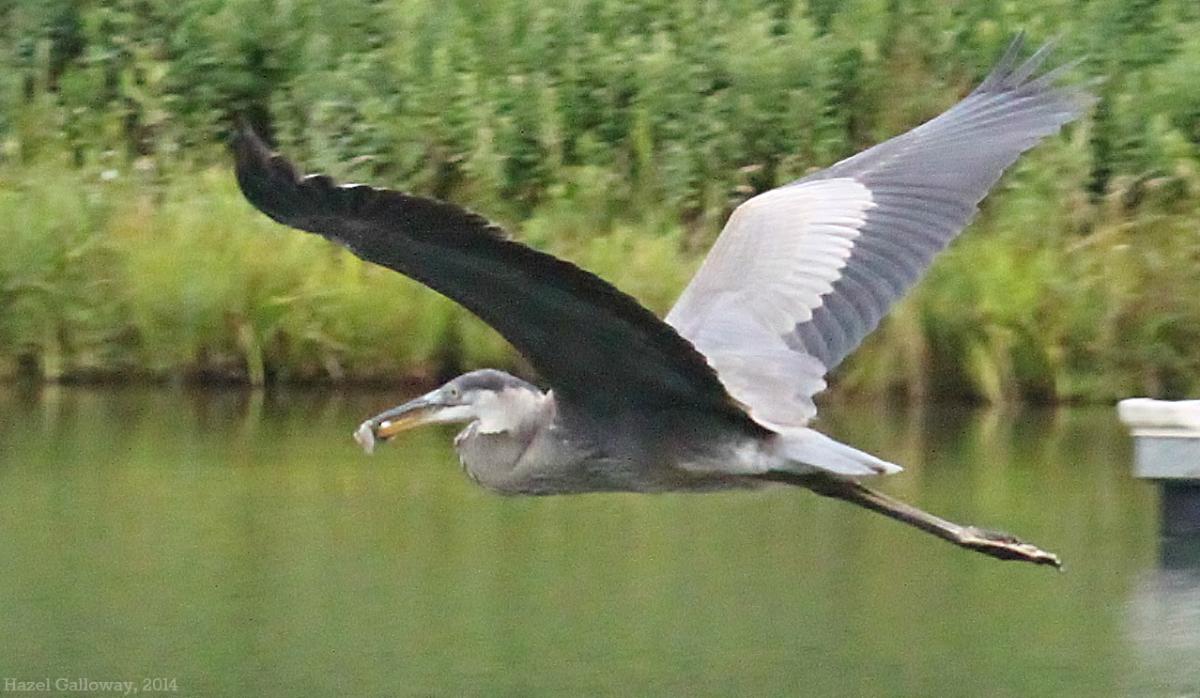The great blue heron is a rare and spectacular visitor at the Station pond. Although it is unfortunately impossible to catch the meter-long bird and put it on display, the pictures on the monitor were taken Sunday morning while the creature was hunting for prey along the banks and in shallow water. Their summer breeding range covers most of North and Central America; however, tend to be found near bodies of water rather bigger than our little pond, such as marshes, lakes, riverbanks, and coastlands. The largest bird in the heron family, they are also one of the most adaptable—some populations overwinter as far north as British Columbia, while others travel to South America during the colder months.
 Great blue herons’ 1.7-2 meter wingspan makes these migrations possible; steady wingbeats can propel them up to 30 miles an hour. When the males arrive at their breeding grounds, they quickly claim an existing nest, although some ambitious young males may build their own. They usually form large, monospecific breeding colonies that may comprise 500 nests in close proximity. This and the great height of their nests—up to 20 m off the ground—likely increase the security of the colony against predators. When the females arrive at the breeding grounds, males make courtship displays by perching on the edges of their nests, stretching their necks, and ruffing their neck feathers, sometimes flying in circles around the nest or shaking twigs to attract females’ attention. Potential mates will perch next to males at the nest and they will raise their crest feathers together and clatter their bills. In successful pair-bonds, which last the entire breeding season, this ritual is repeated occasionally throughout the summer and seems to reinforce the bond.
Great blue herons’ 1.7-2 meter wingspan makes these migrations possible; steady wingbeats can propel them up to 30 miles an hour. When the males arrive at their breeding grounds, they quickly claim an existing nest, although some ambitious young males may build their own. They usually form large, monospecific breeding colonies that may comprise 500 nests in close proximity. This and the great height of their nests—up to 20 m off the ground—likely increase the security of the colony against predators. When the females arrive at the breeding grounds, males make courtship displays by perching on the edges of their nests, stretching their necks, and ruffing their neck feathers, sometimes flying in circles around the nest or shaking twigs to attract females’ attention. Potential mates will perch next to males at the nest and they will raise their crest feathers together and clatter their bills. In successful pair-bonds, which last the entire breeding season, this ritual is repeated occasionally throughout the summer and seems to reinforce the bond.
The pair splits child-rearing duties fairly equally; both sexes incubate the eggs during the month that they take to hatch and feed the chicks in the two ensuing months before they leave the nest. During this period, the parents consume up to four times as much food as normal to feed their chicks by regurgitation. Despite this, starvation is the leading cause of hatchling death, particularly at the time of peak energy demand that occurs at 3-6 weeks of age. Along with the risks of predation, disease, and human disturbance, only about 30% of chicks that hatch in any given year survive to their first birthday. Great blue herons do have the potential to be very long-lived, however, with one individual reaching 23 years old. The young, which are darker in color and lack the long plumes of the adults, don’t mature until their second summer.
These waders hunt fish and other aquatic animals by slow wading in water and crouching on banks. With a quick lunge of their neck, they catch and kill prey with their blade-like bills and swallow it whole. Their long, lithe neck is not without its drawbacks; great blue herons have been known to choke to death while attempting to swallow overlarge prey. It has been shown that herons have greater striking efficiency when standing crouched on the shore than when wading through water; despite this, they spend more time standing upright or wading than they do crouching. A tradeoff seems to exist between amount and quality of prey; it has been found that herons that use slow-wading hunting techniques, which allow them to survey deeper waters, have a diet heavier in larger fish, such as eel and perch.
Although common and widespread, herons are very sensitive to disturbance, and repeated human activity near nest sites often results in abandonment of the nest and eggs or chicks. Interestingly, great blue herons seem to be tolerant of mechanical noises, even when fairly loud. One study done in Ohio found foot traffic to be the most detrimental disturbance to nesting herons.
Hazel Galloway
Sources:



